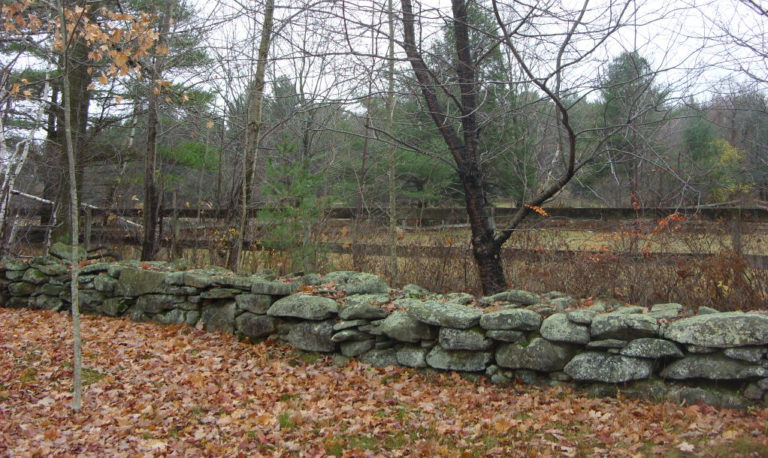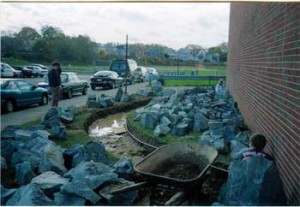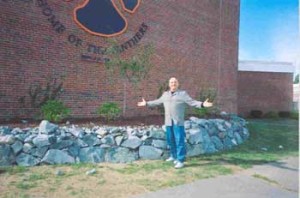Sagas in Stone

Students re-create New England history
Beverly High School’s “Primary Research Through the History of Beverly” class was discussing the Industrial Revolution’s impact on the early nineteenth-century New England farmer. Our focus turned to stone walls, a ubiquitous reminder of the past in New England. In the woods and parks of New England, stone walls serve as a palimpsest of what was once an agricultural landscape. Students were amazed to learn that there are far more trees in Massachusetts today than there were one hundred and fifty years ago. This discussion generated some interesting questions. One student asked if stone walls were made to mark the boundaries of the farms or were they built to keep in livestock? Another wondered if the form of the stone wall had any relation to its agricultural function. These original questions generated a myriad of others leading to a semester-long research project, culminating in a group effort to build a stone wall on the grounds of our high school.
To answer these initial questions, we studied the history of New England stone walls. We learned that they typically enclosed cemeteries, pastures, farms, and animal pounds. We had never before heard of a “fence viewer,” whose job was, according to state law, to monitor all fences in the community for proper condition and height. The measurement of stone walls was particularly fascinating: in colonial Massachusetts, all fences were required to be measured in units of “chains” or “perches.” The term chain originated from the surveying invention of Englishman Edmond Gunther in 1620. Gunther’s chain is a predecessor of the tape measure. The chain was sixty-six feet long, consisting of one hundred links measuring approximately 7.92 inches apiece. Many modern-day units of measure, including furlongs, acres, and miles, are based on Gunther’s sixty-six-foot chain.
Robert Thorson’s Stone by Stone: The Magnificent History in New England’s Stone Walls (2002) identifies the “golden age” of stone walls in New England as between 1775 and 1825. We tested Thorson’s theory by measuring the growth of lichen. Although there are environmental variables that make this dating technique less than perfect, it has proven to be relatively effective. Foliose and crustose lichens (found commonly in New England) grow at fairly predictable rates. For example, crustose lichens grow at a rate of one millimeter per year. By measuring from the center of the lichen to the edge, students could guess the age of the wall. To check the accuracy of their hypotheses, they measured similar lichens on nearby colonial gravestones and checked the estimated date against the date on the front of the stone. This proved the lichen-dating technique (or “lichenometry”) to be reasonably accurate.
Inspired by their readings and by in-class discussions, the class wondered what it would be like to actually build a stone wall. With the help of our enthusiastic principal, Dr. Carla Scuzzarella, who gave us permission to use a location near the front of the high school, we determined the shape and length of the wall. To measure, we made our own Gunther’s chain. Based on the length of our proposed wall (a half chain, or thirty-three feet), we then determined how much stone we needed. As there was no funding for the project, we began searching for a construction company or quarry that would be willing to help. Lillian, one of our students, made dozens of calls to local stone sources. Her diligence was rewarded by Margaret McGinnis of nearby Bevenento Sand and Stone. The company donated over thirty tons of stone and peastone gravel for the project.
We began with only a rudimentary idea of how to build the wall. We turned to Kevin Gardner, the author of The Granite Kiss: Traditions and Techniques of Building New England Stone Walls (2001), for professional guidance. Soon after learning about our project he offered to visit the class. Our students were thrilled that the author of one of their textbooks would show up to offer his expertise. Gardner is an author, teacher, public-radio producer, and most importantly to us, a stone-wall builder.
Kevin used small stones on a table to demonstrate wall building techniques. Students then created their own tabletop stone walls. He is a masterful teacher who so excited the students that they asked him to go outside in the rain with them to view our stones and plan a design. We had planned a thirty-three-foot, semi-circular double wall approximately three-and-a-half feet high (fourteen links on a Gunther’s chain). Kevin suggested that we start from a center point and begin to sort the stones by size and function.
Using a wheelbarrow and dolly (as oxen and plows were unavailable), we began sorting the stones by size and function. We divided the stones into categories of footing stones, cap stones, building stones, corner stones, and rubble stones.
First we dug a trench following an outline drawn by building grounds supervisor Bill Bourque and filled it with peastone gravel. Then, keeping Gardner’s and Bourque’s advice in mind, we began building the wall. We slanted stones to the center for stability and laid one stone over two. We began the wall at both ends as well as the middle to ensure uniformity.
The construction began in October 2004 and was completed by the following summer. The members of the class—Lillian Barres, Justin Desrocher, Megan Nylund, David O’Brien, Sarah O’Shea, and Corey Schweitzer—should be commended for a Herculean effort. The construction of Carla’s Wall (named after our principal) was not the only unit in the course since these students spent hundreds of hours researching all aspects of Beverly’s rich history, including a wonderful class project on colonial gravestone carving.
In addition to class time, the construction of the wall took place before school, after school, on weekends, and on school vacations in all kinds of New England weather. Yet, these students never complained or deviated from their self-appointed goal. We also managed to have fun along the way. We visited Robert Frost’s “Mending Wall” at his family farm in Derry, New Hampshire, and had the opportunity to meet author Robert Thorson after hearing him discuss his book one evening at the Arnold Arboretum in Boston. Along with Kevin Gardner, Robert Thorson was an inspiration to the students and their project.
From these latter-day artisans and from their own labors, the students learned a variety of skills that helped shape them into intellectual decathletes. More importantly, they demonstrated an intellectual hunger and civic virtue that were rarely fueled by the roar of the crowd. They became quiet leaders who got the job done, always thinking of making their school and community a better place without any consideration of personal gain or recognition. The exemplary effort of these dedicated students, along with the support of enthusiastic and altruistic people such as Gardner, Thorson, Bourque, and Benevento Sand and Stone, shows what can be done with a lot of good will and a minimal budget.
We are planning a formal dedication ceremony of Carla’s Wall in May 2006. All are invited. For more details on the project, including student research papers and photos, visit http://www.primaryresearch.org/stonewalls.
This article originally appeared in issue 6.4 (July, 2006).
W. Dean Eastman teaches history at Beverly High School in Beverly, Massachusetts, and has been the recipient of numerous honors and awards, including the Disney American Teacher Award (1991), Harvard University’s Derek Bok Prize for Public Service (2000), and the Preserve America Massachusetts History Teacher of the Year Award (2004).
Kevin McGrath is a library teacher at Newton North High School in Newton, Massachusetts.

